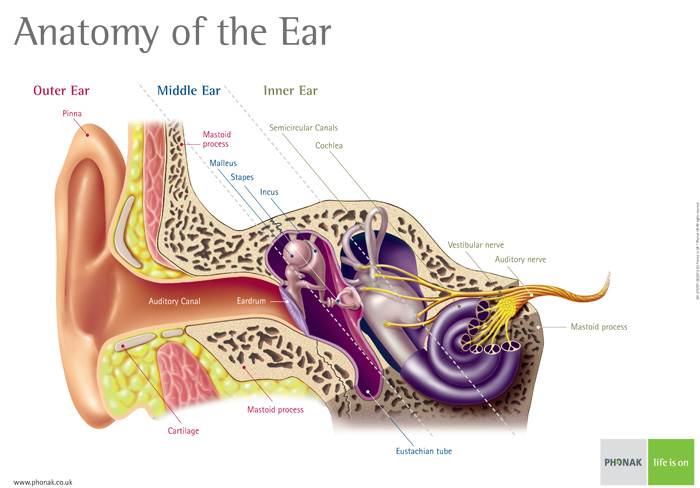How does hearing work?

The ear anatomy is split into three parts, the outer ear, the middle ear and the inner ear. The inner ear is formally called the cochlea. Cochlea is Latin for snail, the cochlea gets its name from its very distinctive shape which is not unlike a snail shell.
The outer ear consists of the pinna (the flap at the side of your head), the ear canal and eardrum. The middle ear consists of the ossicles and ear drum. The inner ear consists of the cochlea and the auditory (hearing) nerve which feeds information to the sound centre of the brain.
Sound as we know it, is in fact movements in air that are called sound waves. Sound waves are guided into the ear canal via the pinna, travel along the canal and make the ear drum vibrate. This action moves the tiny ossicles in the middle ear. The ossicles act as an amplification mechanism. The last bone in this chain plunges the membrane window of the cochlea and makes the fluid in the cochlea move. The fluid movement excites tiny hair cells which triggers a response in the hearing nerve.
What happens when you have problems with hearing?
When your hearing is working normally, sound information is being passed through the different parts of the ear without issue to the auditory centres of the brain. If one part of the chain of hearing fails, you will not hear well. The type of hearing problem you have depends on which part of the ear has the problem.
Outer ear or middle ear problems lead to the inefficient transfer of sound to the cochlea. While the cochlea is still working well, it is not receiving enough sound information. This type of hearing loss is called a conductive hearing loss. The problem is that the sound is not being conducted (transferred) well enough. Conductive deafness can be caused by things such as an earwax, ear infection, a punctured eardrum or a disease called otosclerosis.
An inner ear (cochlear) problem means that sound arrives at the cochlea, but is then not fully passed on to the hearing nerve because of damage to the tiny hair cells. It may also be possible that the hearing nerve itself is not passing on information well, or fails to pass on the sound at all. A cochlear or neural hearing loss is called a sensorineural hearing loss. Sensorineural hearing loss can be caused by things such as old age, Ménière’s Disease or loud noise amongst others. It is also possible to have a mixed hearing loss with both a conductive and sensorineural element.
So if you are interested in hearing aids or a hearing test in Guernsey, why don't you call us on 01 481 245999 for an appointment or book your appointment online below.

